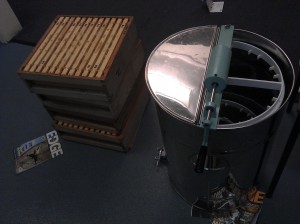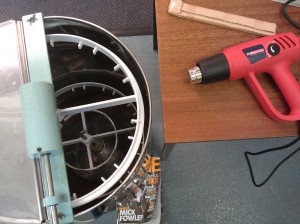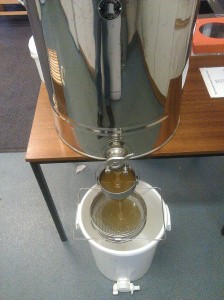Today was an extremely wet day - one in which to do some indoor beekeeping - extracting the rape-seed (canola) honey from Faye’s hives.
There were 5 supers in all, and most of them were pretty full - though with the cold weather and delay in extraction some of it was starting to set in the comb! However we managed to extract around 30kg of honey, with only a small amount lost to crystallisation in the combs.
I’ll be writing some more on the processing and storing of rape honey soon - but the key word is ‘speed’ - this honey will set in the comb in a matter of days or weeks, and if that happens, your best option is to use it as food for the bees, and hope they’ll bring some more liquid honey in later in the year. Once off the hive, it will set within a week, so don’t store it for ages before extracting.
With rape you need to remove the supers before the bees have begun to cap it over. To test, pick up an uncapped frame and vigorously shake it - if the liquid honey doesn’t fall out, you’re ready to extract. Get it off the hive and into your extracting room as quickly as possible!
We brought the supers inside, and as some of them were partially capped over, used a hot-air gun on a medium heat to gently melt the cappings and expose the honey. There’s a very good video of this process online - I was uncertain at first, but having uncapped around 50 frames with no mess or wastage, I’m now sold! The only downside is that there aren’t any wax cappings to melt down and sell at this stage, but given most beekeepers now replace their frames every 3-5 years for hygiene reasons, the wax will be being recycled soon enough.
Video of Using a heat gun to uncap frames.
We then carefully arranged the frames into a 10-frame radial extractor, taking care to evenly distribute the weight of the frames around the wheel (placing equally weighted frames opposite each other is best).
5 minutes of slow spinning, followed by 5 minutes of fast spinning then ensued to ‘throw’ all the honey out of the frames into the tank. The slow spin gives the frames a chance to ‘settle in’ and prevents the initial weight of the honey from tearing the frames apart. Once they’re mostly empty, a faster spin gets out the more stubborn bits.
Finally, the extractor honey tap was opened and the honey allowed to run through 3 levels of mesh sieve into a settling tank. The sieves take out any pieces of wax, bee or other debris that may have entered into the honey during its storage and subsequent extraction.
The honey is then left to settle. With other honeys, it is then transferred into jars, but with rape honey there is a further process of crystallisation and creaming to make set or creamed honey. I’ll hopefully be writing a second post about this once I get a chance to do it!



